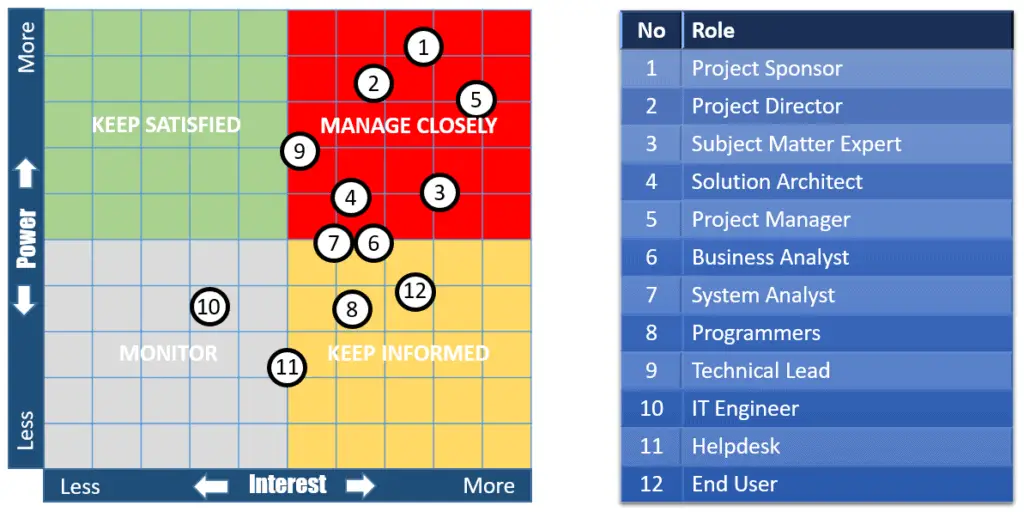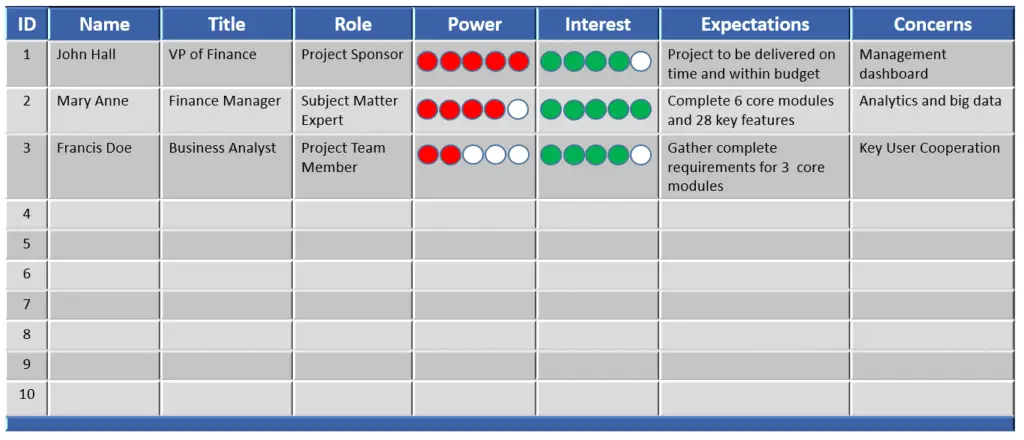If you own a business or are active in project management, you ought to be familiar with stakeholder analysis. How do you rank your key stakeholders in terms of the power and interest that they hold? It is crucial in every business that you get to analyze your stakeholders. This will come in handy during different decision-making processes about the business or project.
This article offers you a step-by-step guide on coming up with a stakeholder analysis to help you familiarize and grasp the concept of stakeholder analysis and improve your projects or businesses. We will look at why it is important to have a stakeholder analysis, who is involved, when to come up with a stakeholder analysis, and even guide you on how to create a stakeholder analysis.
I hope that this article is insightful and helps you better control your project and make decision-making easy. Stick to the end to learn all you can learn about stakeholder analysis and how to use this technique to improve your project delivery abilities in project management.


What is a Stakeholder Analysis?
Stakeholders can either be the people or teams involved in a given project or those affected by the project. A stakeholder analysis is a systematic way of identifying these people before the commencement of the project and classifying them according to their interest and power as well as their level of participation. By doing so, you understand how to best involve and communicate best with each of the stakeholders.
Why Should You Conduct a Stakeholder Analysis?
This is often the best way to kickstart any project you are undertaking. It enables you to identify as many stakeholders as possible from the onset. In turn, this gives you the opportunity to tailor your communication to suit the stakeholder you want to engage, thereby increasing your chances of getting their approvals in your project.
Also, by using the opinions and influence of the important and powerful stakeholders, you put your project at better chances of succeeding. This is because you will not waste time or resources updating the stakeholders with minimal interest ad who don’t need all that communication.
In addition, you can use influential and powerful stakeholders to acquire resources for the project. Conducting a stakeholder analysis will also help you prioritize the competing demands for the limited resources and meet your deadlines.
If a project stands to impact the involved stakeholders positively and benefit them, they will show their support for it. Unfortunately, the opposite is also true. If a project or product is bound to affect certain stakeholders negatively, you can bet that they will do anything within their power to try and block your efforts. It is for this reason that you should identify the involved parties/ stakeholders as early as possible and figure out how you will deal with them.
You will be able to prepare mentally for any obstacles you are likely to face once the project has kicked off. You can also come up with means of convincing the aggrieved parties that the project is meant for the greater good or that you have a way of fixing and dealing with their concerns.
Who is a Stakeholder?
As mentioned before, a stakeholder is anyone with vested interests in the project you are undertaking. Stakeholders can either be internal or external. The external stakeholders are the clients. These are the people you are undertaking the project for. Therefore, the client, their managers or directors, or anyone from the client project team forms part of the external stakeholders.
The internal stakeholders are the top leadership of the organization. These are people such as the executive managers, finance managers, and directors. Their main interest is to see the project run smoothly and make a profit for the organization.
The project team is also part of the stakeholders. They fall under the internal category. However, they have more interest on the project than the top leadership because they are devoted and committed to working on the project. This is normally made up of qualified people with skills essential to the project’s success.
Lastly, the other stakeholders who are sometimes forgotten about is the community. This may consist of the end-users or influencers of a project. They are the people who the project will affect in one way or the other.
When to Conduct a Stakeholder Analysis and Involve the Stakeholders
You should conduct your stakeholder analysis before the commencement of a given project. This enables you to know everyone invested in the project so that you can be able to meet their expectations. Conducting stakeholder analysis from the onset prevents you from leaving out any crucial stakeholder, while also allowing you to understand their priorities at the same time.
There are different types of stakeholders in a project, and it is important to note that they are not always involved at the same time. Their participation levels differ, and therefore, you should know when to engage with them. You should have a defined communication frequency.
For instance, for the clients, you may need to do a well-detailed high-level report weekly. The internal stakeholders will also require regular updates, mostly for accountability purposes. This ensures that the project team is on schedule by comparing the predicted hours to the spent hours in undertaking the project.
Other stakeholders, especially those with high power but low interest, need to be engaged on a monthly basis unless where a major decision needs to be made, and their input is required. The monthly updates can bring them up to speed with the progress and seek their input and feedback.
Even though stakeholder analysis should be done at the onset of a project, it is an ongoing process. Depending on how long a project runs, stakeholders will constantly change, meaning that opinions are likely to change. The whole project might eventually change as well. Since stakeholder analysis aims at ensuring all stakeholders are satisfied, it will have to be an ongoing process to ensure that the new stakeholders are catered for.
You may choose to conduct your analysis every half a year or before the commencement of each phase of the project. No matter how frequent or far apart you place the analysis, you should allocate enough resources to conduct the processes seamlessly.
How to create a Stakeholder Analysis
it is important to note that stakeholder analysis will differ depending on the company or organization. There are also different models used in analyzing stakeholders. It is wise to let your project’s nature and the availability of resources guide you on the model of analysis to use. An organization may also choose to use different models to get a better understanding of its stakeholders.
However, you will find that there are crucial steps that are common in most of the analyses. Below are steps to guide you on how to come up with a personalized stakeholder analysis.
Find out who the stakeholders are
Before working on anything you need to brainstorm with your team to determine the people likely to be involved or affected by the project. It would be best to come up with a list of all the stakeholders, which could be the Executive staff, the IT team, Sales and Financial officers, procurement, marketing team, consultants and many more depending on your project.
Ensure that you do not fail to include any key stakeholder at this early stage. This is critical as some may even affect the commencement of the project.
Classify the stakeholders
Once you have determined the stakeholders, it is time to group and prioritize them based on their influence on the project. The categories you come up with should reflect their power, interest in the project, and participation level depending on the role they play in the project.
You can have a power and interest grid to guide you. You will realize that there are different categories.
- The high power, high-interest stakeholders. These are the most valuable and crucial stakeholders in your project. It would help if you kept them happy by making great strides and progress with the project. You need to deliver your project in time and within the budget to be on good terms with them.
- The high power, low-interest stakeholders. These stakeholders need to be kept satisfied because of the great influence they have. However, avoid overcommunicating and updating them on every tiny detail to avoid turning them off.
- The low power, high-interest stakeholders. You need to update and check in regularly with these stakeholders to see if they are experiencing any problems with the project and how to deal with their concerns.
- The low power, low-interest stakeholders. These stakeholders have the lowest form of influence on the project. However, you should update them periodically and be careful not to overdo it since they are not involved with the project.
From the categories we have mentioned above, you can easily point out that the high power, high-interest stakeholders are the key players in the sector. These are the people you want to collaborate with and have them fully engaged in the project.
The low power, high-interest stakeholders, are the subjects. These are individuals who can offer you great and helpful insights on the project but whom you do not always need to engage or say yes to. The high power, low-interest stakeholders, are the context-setters. These are people such as the head of departments, for instance, the finance department. They have a lot of influence on the project’s logistics but do not want to be constantly involved and have every tiny detail.
Lastly, the low power, low-interest stakeholders are the crowds. They will require to be updated regularly on the project’s progress. They are the least of the stakeholders, but that does not mean that they do not require any form of communication.
Communication strategy and winning the stakeholders’ buy-ins
For your project to be successful, you will need the support of each of the stakeholders. Therefore, you need to come up with a strategy of how to communicate best with them to get them to back you up and win their buy-in.
To achieve this, find out what motivates your stakeholders and use that to win their heart. It would help if you also did a bit of research to discover any other priorities they may have and how you can align the project to their priorities. This is likely to pick their interest and their interest and involvement. While at it, ensure that the project does not threaten their other interests to prevent them from causing obstacles for you every step of the way.
You should also find out if the stakeholder has a positive reception towards the project. If the attitude is negative, find out what you can do about it to prevent any hindrances while undertaking the project.
Conclusion
Conducting a stakeholder analysis plays a key role in project’s success. It allows you to identify all the key stakeholders from the onset. Having all stakeholders on board keeps unnecessary hitches out of your path once the project has commenced since everyone will be on the same page in terms of goals. The project team will also know what success looks like at the end of the project.
The different stakeholders involved in a project need to be communicated with and updated regularly. However, be careful not to overcommunicate to those stakeholders with low interest as that may turn them off. Also, remember that stakeholder analysis is an ongoing process and not something you only do before starting a project. This is because stakeholders may change during the lifecycle of a project. Opinions may also change, and so will interests and priorities.
Like we mentioned, to increase the chances of your project succeeding, ensure that you align other priorities that your stakeholders may have to spark their interest. I hope that this article helps you have a smoother relationship with the stakeholders for your project’s success.
Click here to download Stakeholder Analysis Template.

